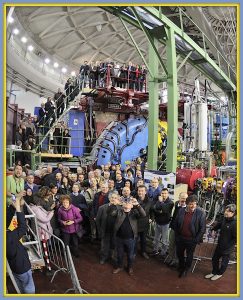 On the 30th of March, on the occasion of the KLOE-2 experiment data-taking at DAΦNE, the Φ-factory collider, a ceremony was held in the Bruno Touschek Auditorium at LNF to commemorate the almost twenty years of operation of the KLOE detector.
On the 30th of March, on the occasion of the KLOE-2 experiment data-taking at DAΦNE, the Φ-factory collider, a ceremony was held in the Bruno Touschek Auditorium at LNF to commemorate the almost twenty years of operation of the KLOE detector.
In an overcrowded hall, after welcoming the participants and the thanks by the LNF Director, Pierluigi Campana, Sergio Bertolucci, former KLOE technical director, recalled the story of the KLOE experiment, from its initial project – promoted by Nicola Cabibbo and Paolo Franzini – until the closing of the first data-taking in 2006.
The most important results in physics obtained analyzing the data collected by KLOE were summarized in the speech by Filippo Ceradini, senior member of the collaboration and supervisor of several graduate and PhD thesis developed in the framework of KLOE and KLOE-2.
Catia Milardi, current leader of the DAΦNE team, remembered the fundamental achievements reached at DAΦNE, among which the implementation in these last years of an innovative configuration of the beam interaction region called “crab-waist” and developed in Frascati starting from an idea of Pantaleo Raimondi. The excellent work of the DAΦNE team allowed to achieve and surpass the ambitious luminosity goal set for KLOE-2, with the experiment successfully acquiring more than 5 fb−1 of luminosity, in little more than three years of data-taking.
Fabio Bossi, previous spokesperson of the KLOE-2 collaboration, gave a speech about the genesis of the KLOE-2 program, based on the fully exploit of KLOE and the improvement of its performances by developing of new specific sub-detectors. Then he remembered the stages of construction and installation of the detectors ended in 2013.
Antonio Di Domenico, the current spokesperson, retraced the main milestones of the KLOE-2 data-taking, started on the 17th of November 2014 and finished on the 30th of March 2018, during the closing ceremony. Actually, at the end of his speech, Di Domenico connected live to the KLOE-2 control room, checked the state of the data-taking still ongoing at that time, and invited the INFN President, Fernando Ferroni, to officially close the KLOE-2 data-taking, pushing the “End” button on the remote control board, in a moment of solemnity, sharing and great emotion for the audience.
Then President Ferroni, in his conclusions, congratulated the KLOE and KLOE-2 collaborations and the DAFNE team on the objective achieved and for having being able to successfully overcome the difficulties of the initial phase of the project.
“The rich data sample acquired by KLOE and KLOE-2, corresponding to 8 fb−1 of luminosity and 24 billion of Φ mesons produced, is worldwide unique in terms of typology and statistical relevance” stresses Antonio Di Domenico, “and it is extremely prolific in terms of results. Actually, thanks to the high quality of the data collected, several data analysis – not initially foreseen at design stage – have produced and are going to produce a significant number of scientific results.”
The ongoing analysis will allow to complete the broad KLOE-2 physics program providing important results in several fields, including tests of the fundamental matter-antimatter symmetry of Nature with unprecedented precision, the precision study of the quantum entanglement phenomenon, the study of rare K and η-meson decays and that of strong interactions in low energy processes, photon-photon fusion processes, and the search for new exotic particles as possible manifestation of the dark matter.
The closing of the KLOE-2 data-taking will also mark the conclusion of a long period of activity of the Laboratories that – first with the KLOE experiment, then with KLOE-2 – has involved, on an accelerator machine in Italy, several generations of Italian and foreign physicists in an extraordinary and challenging human and scientific enterprise.
“KLOE meant so much to Frascati and particle physics at INFN” emphasized the LNF Director, Pierluigi Campana, “however our scientific curiosity does not end here. Soon, again using the DAΦNE machine, the PADME data-taking will start, followed by the one of Siddharta2. Furthermore, we are thinking about becoming a centre of excellence in accelerator physics, by revitalizing DAΦNE and applying to host the future EuPRAXIA, the first European plasma-based Free Electron Laser.”
Translation by Camilla Paola Maglione, Communications Office INFN-LNF
 INFN-LNF Laboratori Nazionali di Frascati
INFN-LNF Laboratori Nazionali di Frascati